Are you curious about the incredible wildlife you might encounter while scuba diving in Vietnam? A Bird Of Species A When Diving Can Travel underwater, and with SIXT.VN, planning your Vietnamese adventure is easier than ever! Discover unique marine life, enjoy hassle-free airport transfers, find the perfect hotel, and book unforgettable tours.
1. Diving Birds: An Unexpected Underwater Encounter
Have you ever imagined seeing a bird underwater while diving? It might sound unusual, but several bird species are adept at diving and swimming beneath the surface. These amazing creatures have evolved special adaptations that allow them to thrive in both the avian and aquatic worlds. From streamlined bodies to webbed feet and specialized feathers, diving birds are truly remarkable.
1.1. The Surprise of Seeing a Bird Underwater
Many divers are surprised and fascinated by the sight of a bird underwater. Seeing a bird gracefully swimming alongside fish can be an unforgettable experience. These encounters offer a unique perspective on the interconnectedness of marine and avian life.
2. Cormorants: The Masters of Underwater Pursuit
Cormorants are among the most frequently observed diving birds. Known for their sleek black plumage and exceptional diving abilities, these birds are commonly seen hunting for fish beneath the waves.
2.1. Brandt’s Cormorant: A Pacific Coast Diver
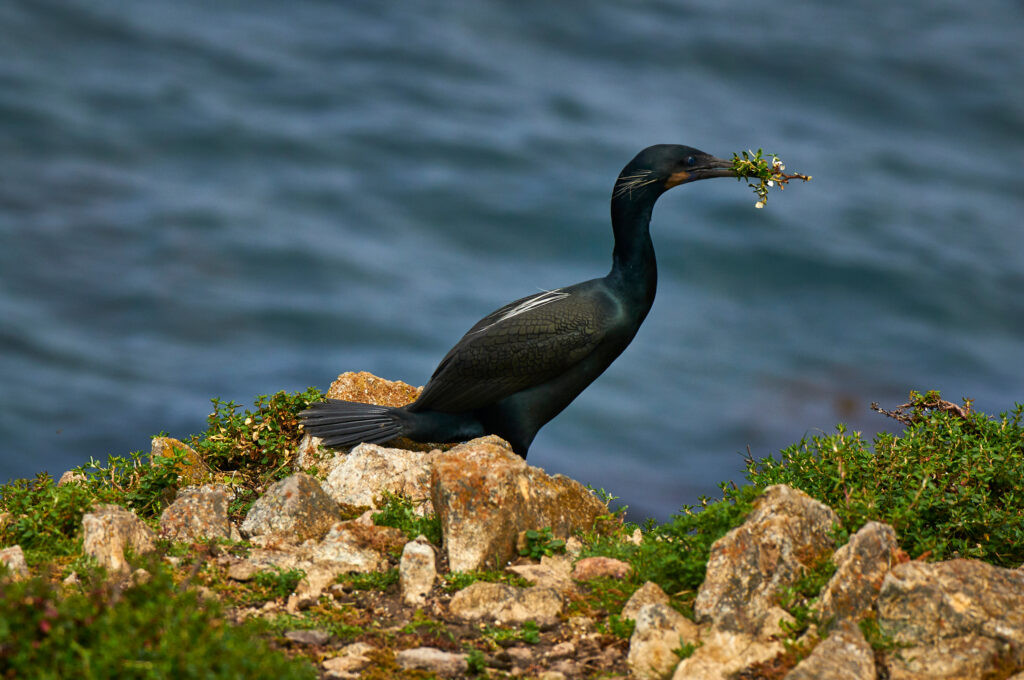 Brandt's Cormorants Gathering Plants
Brandt's Cormorants Gathering Plants
The Brandt’s Cormorant is a prominent species along the Pacific coast of North America. These birds are skilled divers, often plunging to depths of over 200 feet in search of small fish. According to research from the National Park Service, Brandt’s Cormorants are well-adapted for underwater foraging, using their webbed feet and streamlined bodies to maneuver efficiently (National Park Service, n.d.). Their feathers are not waterproof, which helps them dive deeper. After diving, they stand with their wings spread to dry.
2.2. Identifying Cormorants
Cormorants are easily identified by their dark feathers, long necks, and hooked bills. During breeding season, the Brandt’s Cormorant develops a vibrant cobalt blue throat, adding to its distinctive appearance.
3. Pelicans: The High-Diving Fishermen
Pelicans are another group of birds known for their impressive diving skills. These large birds are often seen soaring above the coastline before plunging into the water to scoop up fish.
3.1. California Brown Pelican: A Coastal Icon
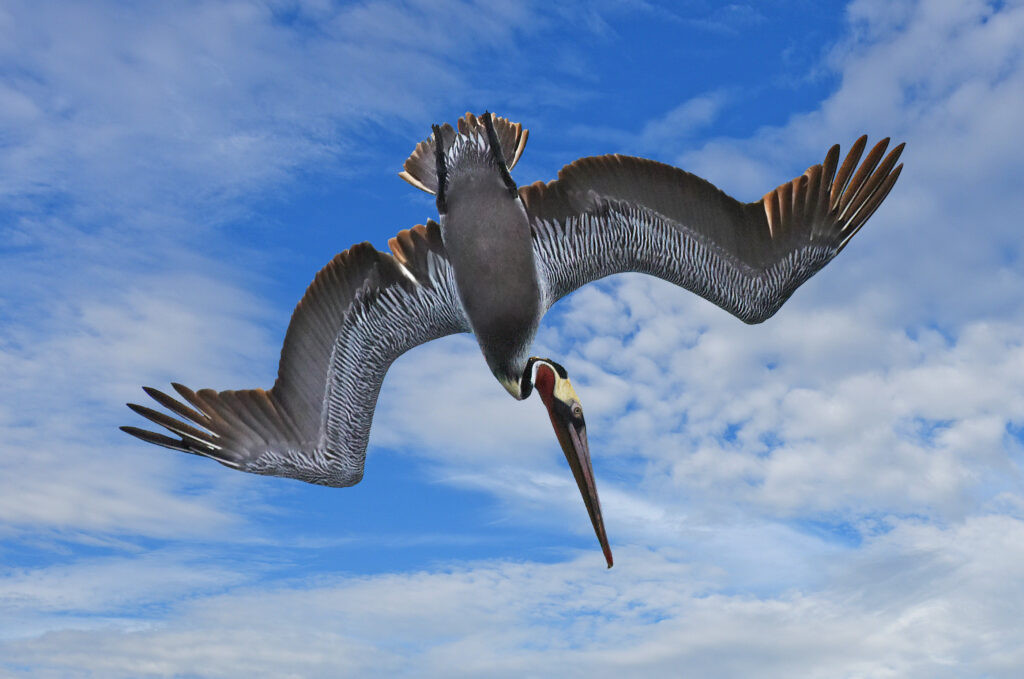 California Brown Pelican Diving
California Brown Pelican Diving
The California Brown Pelican is a familiar sight along the California coast. These pelicans dive from heights of up to 100 feet, using the force of their entry to stun fish. The brown pelican dives into the water from ten to thirty feet in the air, but can dive from as high as 100 feet! When it hits the water, the force of their entry can stun fish as deep as six feet below. According to the San Diego Zoo, Brown Pelicans have a unique feeding strategy, using their large pouch to scoop up fish and drain water before swallowing their catch (San Diego Zoo, n.d.).
3.2. Pelican Feeding Strategies
Pelicans have different feeding strategies, but the brown pelican is actually the smallest. They open their bills underwater so they can scoop and store fish in their large pouches. Then at the surface they drain the pouches of water and eat the fish.
4. Puffins: The Colorful Arctic Divers
Puffins are charming birds found in the northern hemisphere. With their bright beaks and distinctive plumage, puffins are a delight to observe both above and below the water.
4.1. Atlantic Puffin: A Northern Hemisphere Favorite
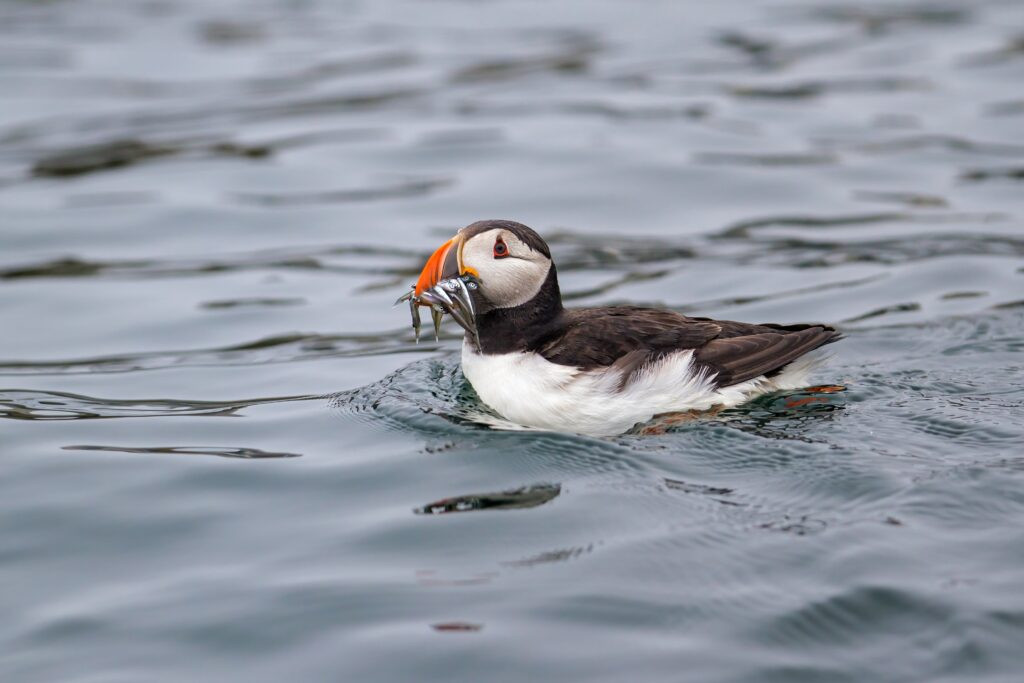 Atlantic Puffin at Surface with Fish
Atlantic Puffin at Surface with Fish
The Atlantic Puffin is the smallest of the four species, is known to be gregarious and confident, and is a favorite of birdwatchers. They’re the only puffins found in the Atlantic Ocean so you’d visit places like Maine, Newfoundland, and the United Kingdom to observe and dive with them. The Atlantic Puffin dives to depths of up to 200 feet in search of small fish. They dive as deep as 50 feet usually, but are capable of diving to 200 feet! They use their wings to propel themselves underwater, much like they do in the air. According to research from the Smithsonian Ocean, Atlantic Puffins are well-adapted to cold water environments, with dense plumage and a high metabolic rate (Smithsonian Ocean, n.d.).
4.2. Puffin Nicknames
Puffins also have some cute nicknames due to their coloring. My favorite is the “sea parrot” because the colorful orange and yellow on their beaks and faces contrast against the distinguished look of their black and white plumage.
5. Penguins: The Flightless Aquatic Experts
Penguins are perhaps the most well-known diving birds. These flightless birds are perfectly adapted to life in the water, with streamlined bodies and powerful flippers for swimming.
5.1. Little Penguin: A Southern Hemisphere Gem
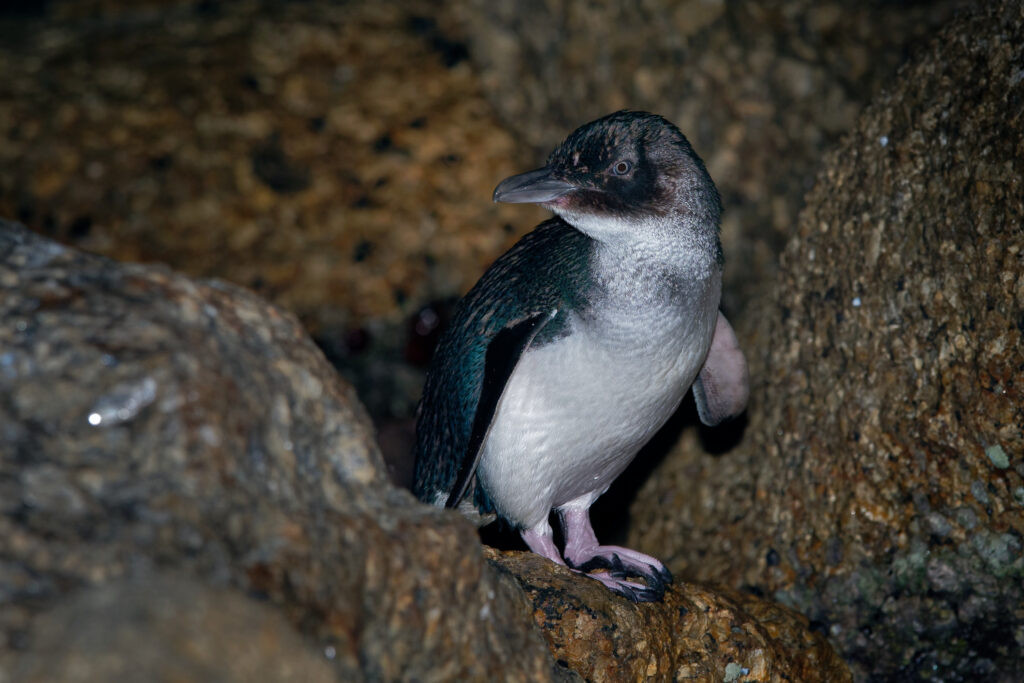 Little Penguin on Rocks
Little Penguin on Rocks
The Little Penguin, also known as the Little Blue Penguin or Fairy Penguin, is the smallest penguin species. They feed in shallow waters, can dive down to 30 feet, and can swim at speeds of up to 4 mph. They are found in New Zealand and Southern Australia. According to the Department of Conservation in New Zealand, Little Penguins spend up to 75% of their lives in the water (Department of Conservation, n.d.).
5.2. Penguin Adaptations
Penguins differ from the previous three diving birds by the fact that they are the only ones that do not fly. Penguins have fully adapted to living mostly in the water! They can spend up to 75% of their lives in the water. The feathers on the majority of their body are dark blue, blue-gray to black, and white on their chest and belly. This is especially helpful for them to camouflage as they swim in the ocean.
6. Planning Your Bird-Watching Dive Trip to Vietnam with SIXT.VN
Planning a trip to Vietnam to observe these incredible diving birds and explore the underwater world can be an exciting adventure. However, organizing all the details can be challenging. That’s where SIXT.VN comes in!
6.1. SIXT.VN: Your Travel Companion in Vietnam
SIXT.VN offers a comprehensive range of services to make your trip to Vietnam seamless and enjoyable. From airport transfers to hotel bookings and guided tours, SIXT.VN has you covered.
6.2. Services Offered by SIXT.VN
| Service | Description | Benefits |
|---|---|---|
| Airport Transfers | Safe and convenient transportation from the airport to your hotel. | Avoid the hassle of public transport or taxis. Enjoy a comfortable and stress-free arrival. |
| Hotel Bookings | A wide selection of hotels to suit your budget and preferences. | Choose from a variety of options, from budget-friendly accommodations to luxury resorts. |
| Guided Tours | Expertly curated tours to explore the best of Hanoi and surrounding areas. | Discover hidden gems and iconic landmarks with knowledgeable guides. |
| Flight Bookings | Assistance with booking the best flights for your travel dates. | Find the most convenient and affordable flights for your trip. |
| Customized Itineraries | Tailored travel plans to match your interests and time frame. | Experience a personalized adventure that caters to your specific needs. |
| 24/7 Support | Dedicated customer support available around the clock. | Get assistance whenever you need it, ensuring a smooth and worry-free trip. |
6.3. How SIXT.VN Solves Common Travel Challenges
| Challenge | How SIXT.VN Helps |
|---|---|
| Difficulty Planning Your Trip | SIXT.VN provides expert travel advice and customized itineraries to simplify your planning process. |
| Language and Cultural Barriers | With local expertise and multilingual support, SIXT.VN helps you navigate cultural differences and communicate effectively. |
| Finding Reliable Services | SIXT.VN offers trusted and high-quality services, ensuring a safe and enjoyable travel experience. |
| Transportation Difficulties | SIXT.VN provides convenient airport transfers and transportation options to help you get around easily. |
| Booking Accommodation | SIXT.VN offers a wide range of hotel options, making it easy to find the perfect place to stay. |
7. Exploring Hanoi: A Base for Your Diving Bird Adventure
Hanoi, the capital of Vietnam, is an excellent base for exploring the country’s diverse landscapes and wildlife. With SIXT.VN, you can easily arrange tours and transportation to various diving spots and natural reserves.
7.1. Must-Visit Attractions in Hanoi
| Attraction | Description |
|---|---|
| Hoan Kiem Lake | A serene lake in the heart of Hanoi, perfect for a peaceful stroll. |
| Old Quarter | A bustling historic district with narrow streets, traditional shops, and delicious street food. |
| Temple of Literature | Vietnam’s first university, showcasing traditional architecture and beautiful gardens. |
| Ho Chi Minh Mausoleum | The final resting place of Ho Chi Minh, a significant historical site. |
| Water Puppet Show | A unique and entertaining traditional art form. |
7.2. Day Trips from Hanoi
| Destination | Description |
|---|---|
| Ha Long Bay | A stunning UNESCO World Heritage site with emerald waters and towering limestone islands. Perfect for kayaking and boat tours. |
| Sapa | A mountainous region known for its breathtaking scenery, rice terraces, and ethnic minority cultures. |
| Ninh Binh | Known as “Ha Long Bay on land,” Ninh Binh features picturesque landscapes with limestone karsts and tranquil rivers. |
| Cuc Phuong National Park | Vietnam’s oldest national park, offering diverse flora and fauna, hiking trails, and primate rescue center. |
| Mai Chau | A peaceful valley with traditional villages and stunning natural beauty, perfect for cycling and cultural immersion. |
8. Diving in Vietnam: Where to See Diving Birds
While Vietnam may not be the first place that comes to mind for diving with birds, certain coastal areas and islands offer opportunities to observe these creatures in their natural habitat.
8.1. Best Diving Spots in Vietnam
| Location | Description | Diving Bird Sightings |
|---|---|---|
| Phu Quoc Island | Known for its clear waters, diverse marine life, and beautiful beaches. | Cormorants and pelicans can be seen diving for fish near the shore. |
| Nha Trang | A popular diving destination with vibrant coral reefs and a variety of marine species. | Keep an eye out for cormorants and other seabirds hunting in the area. |
| Con Dao Islands | A remote archipelago with pristine waters, abundant marine life, and stunning natural landscapes. | Con Dao is home to several species of seabirds, including cormorants and boobies, which may be seen diving for food. |
| Cu Lao Cham | A group of islands near Hoi An, offering excellent diving and snorkeling opportunities. | Cormorants and other seabirds are common in the area, often seen diving near the islands. |
| Whale Island (Hon Ong) | A small island off the coast of Nha Trang, known for its calm waters and diverse marine life. | Pelicans and cormorants are frequently seen diving for fish around the island. |
8.2. Tips for Ethical Bird Watching While Diving
| Tip | Description |
|---|---|
| Maintain a Safe Distance | Avoid approaching or disturbing birds while they are diving or feeding. |
| Avoid Flash Photography | Refrain from using flash photography, as it can startle and disorient birds. |
| Respect Nesting Areas | Be mindful of nesting areas and avoid getting too close to prevent disturbing breeding birds. |
| Do Not Feed the Birds | Feeding birds can disrupt their natural foraging behavior and make them dependent on humans. |
| Support Sustainable Tourism | Choose tour operators and guides who prioritize conservation and responsible wildlife viewing practices. |
9. What Diving Certifications Should Travelers Have?
To safely enjoy diving in Vietnam and observe diving birds in their natural habitat, it’s important to have the appropriate diving certifications.
9.1. Essential Diving Certifications
| Certification | Description |
|---|---|
| Open Water Diver (PADI, SSI, NAUI) | This is the entry-level certification that allows you to dive to a maximum depth of 18 meters (60 feet). It provides the foundational knowledge and skills needed for safe diving. |
| Advanced Open Water Diver (PADI, SSI, NAUI) | This certification builds upon the Open Water Diver course, allowing you to dive to a maximum depth of 30 meters (100 feet) and introduces you to specialized diving activities like navigation and deep diving. |
| Rescue Diver (PADI, SSI, NAUI) | This course focuses on developing your ability to prevent and manage problems in the water, making you a more confident and responsible diver. |
| Enriched Air Nitrox Diver (PADI, SSI, NAUI) | This certification allows you to dive with enriched air mixtures (Nitrox), which can extend your bottom time and reduce the risk of decompression sickness. |
| Underwater Naturalist (PADI) | This specialty course enhances your understanding of the marine environment and the interactions between marine organisms, making your dives more enriching and educational. |
9.2. Why Certification Matters
Diving certifications ensure that you have the necessary knowledge, skills, and safety training to explore the underwater world responsibly. Certified divers are better equipped to handle potential hazards and minimize their impact on the marine environment.
10. Essential Travel Tips for Vietnam
Planning a trip to Vietnam requires some preparation to ensure a smooth and enjoyable experience. Here are some essential travel tips to keep in mind.
10.1. Pre-Departure Checklist
| Task | Description |
|---|---|
| Visa Requirements | Check visa requirements based on your nationality and apply in advance if necessary. Many countries are eligible for e-visas, which can be obtained online. |
| Travel Insurance | Purchase comprehensive travel insurance that covers medical emergencies, trip cancellations, and loss of belongings. |
| Vaccinations | Consult your doctor about recommended vaccinations for Vietnam. Ensure that you are up-to-date on routine vaccinations and consider getting vaccinated against diseases like hepatitis A, typhoid, and Japanese encephalitis. |
| Currency and Payment Methods | Vietnamese Dong (VND) is the local currency. While credit cards are accepted in major hotels and restaurants, it’s advisable to carry cash for smaller establishments and local markets. Inform your bank about your travel dates to avoid any issues with your cards. |
| Packing Essentials | Pack light, comfortable clothing suitable for tropical weather. Include essentials like sunscreen, insect repellent, a hat, and comfortable walking shoes. If you plan to visit religious sites, pack modest clothing that covers your shoulders and knees. |
| Learn Basic Vietnamese Phrases | Learning a few basic Vietnamese phrases can enhance your interactions with locals and make your trip more enjoyable. Phrases like “Xin chào” (hello), “Cảm ơn” (thank you), and “Bao nhiêu?” (how much?) can be very useful. |
10.2. On-Arrival Checklist
| Task | Description |
|---|---|
| Airport Procedures | Have your passport, visa (if required), and any necessary travel documents readily available for immigration and customs. Follow the signs for baggage claim and proceed to the designated area. |
| Transportation from the Airport | Arrange for airport transfers in advance through SIXT.VN for a hassle-free journey to your hotel. Alternatively, you can take a taxi or use ride-hailing apps like Grab, but ensure the meter is running or agree on the fare beforehand. |
| SIM Card or Portable Wi-Fi Device | Purchase a local SIM card or rent a portable Wi-Fi device to stay connected during your trip. This will allow you to access maps, translation apps, and communicate with family and friends. |
| Accommodation Check-In | Present your passport and booking confirmation at the hotel reception. Inquire about hotel amenities, breakfast timings, and local transportation options. Familiarize yourself with the hotel’s emergency procedures. |
| Local Transportation Options | Learn about local transportation options such as buses, taxis, and motorbike taxis (xe ôm). Be cautious when using motorbike taxis and always wear a helmet. Consider using ride-hailing apps for convenience and fare transparency. |
| Cultural Sensitivity | Dress modestly when visiting religious sites. Remove your shoes before entering temples and pagodas. Avoid loud or disruptive behavior in quiet or sacred places. Always ask for permission before taking photos of people, especially in rural areas. Be respectful of local customs and traditions. |
11. Frequently Asked Questions (FAQs)
11.1. What bird species can travel underwater when diving?
Cormorants, pelicans, puffins, and penguins are known for their diving abilities, using unique adaptations to swim and hunt underwater.
11.2. Where can I see diving birds in Vietnam?
You can spot diving birds in coastal areas like Phu Quoc Island, Nha Trang, Con Dao Islands, and Cu Lao Cham.
11.3. What services does SIXT.VN offer?
SIXT.VN offers airport transfers, hotel bookings, guided tours, flight bookings, and customized itineraries.
11.4. How can SIXT.VN help me plan my trip?
SIXT.VN simplifies your planning process with expert advice, reliable services, and convenient booking options.
11.5. What diving certifications do I need?
Open Water Diver and Advanced Open Water Diver certifications are recommended for safe diving experiences.
11.6. What should I pack for my trip to Vietnam?
Pack light clothing, sunscreen, insect repellent, a hat, and comfortable walking shoes.
11.7. Is it safe to dive in Vietnam?
Yes, with proper certification, reputable dive operators, and adherence to safety guidelines.
11.8. What are some must-visit attractions in Hanoi?
Hoan Kiem Lake, Old Quarter, Temple of Literature, and Ho Chi Minh Mausoleum are popular attractions in Hanoi.
11.9. How can I respect local customs in Vietnam?
Dress modestly in religious sites, remove shoes before entering temples, and ask for permission before taking photos.
11.10. What is the local currency in Vietnam?
The local currency is Vietnamese Dong (VND).
12. Dive into Adventure with SIXT.VN
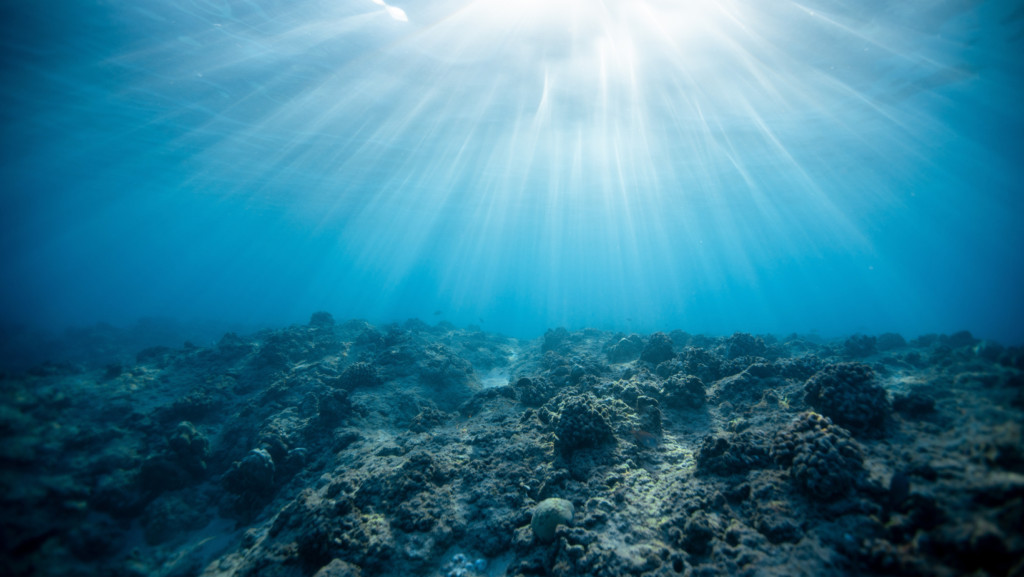 Underwater Naturalist Course
Underwater Naturalist Course
Ready to embark on an unforgettable diving adventure in Vietnam and witness the incredible diving birds in their natural habitat? Let SIXT.VN take care of all the details, from airport transfers to hotel bookings and guided tours. Visit SIXT.VN today and start planning your dream trip to Vietnam!
Address: 260 Cau Giay, Hanoi, Vietnam
Hotline/Whatsapp: +84 986 244 358
Website: SIXT.VN
References:
- National Park Service. (n.d.). Brandt’s Cormorant. Retrieved from https://www.nps.gov/chis/learn/nature/brandts-cormorant.htm
- San Diego Zoo. (n.d.). Pelican. Retrieved from https://animals.sandiegozoo.org/animals/pelican
- Smithsonian Ocean. (n.d.). Puffins. Retrieved from https://ocean.si.edu/ocean-life/seabirds/know-your-puffins
- Department of Conservation. (n.d.). Little Penguin/Korora. Retrieved from https://www.doc.govt.nz/nature/native-animals/birds/birds-a-z/penguins/little-penguin-korora/



